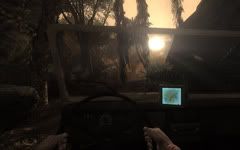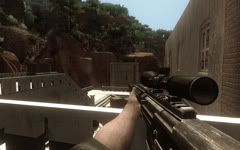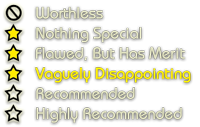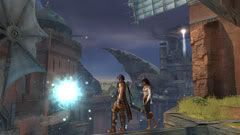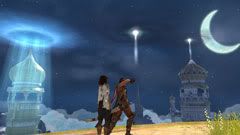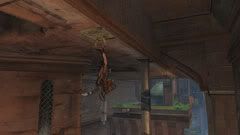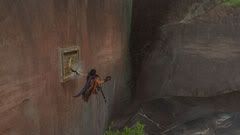
All right, so let's run through our CryHistory one more time. In 2004, a little-known developer named Crytek made Far Cry for Ubisoft, a graphically striking first-person shooter set in a sprawling tropical environment. In 2007 they went on to make Crysis for EA Games, which had similar story-driven free-roaming outdoor gameplay but a completely unrelated story. In 2008, a completely unrelated team of developers at Ubisoft made Far Cry 2, which is also completely unrelated to Far Cry in storyline terms, and plays a lot less like Far Cry than Crysis does. Confused? You should be. Basically you might just as well call this game Fun With Malaria, because it truly isn't a sequel to Far Cry in any way. But with Far Cry's inconsequential storyline and Crysis so nicely filling the story-driven jungle-shooter void, that's not really a bad thing.
The gist of Far Cry 2 is that you're a mercenary in Africa, you have Malaria, and there are 2 warring factions who are both being supplied by an arms dealer called The Jackal. It's an "open-world" game with various missions that you can do in almost any order. It has a realistic day-and-night cycle and almost no menu interfaces or loading screens; in-game time is only skipped during sleep, bus rides, and a few key story moments. There is also almost no HUD to speak of, with ammo and health indicators only popping up when they're needed, and the world map actually appears as a real object held in your hand. (Markers do appear on the map through what appears to be magic, but the game would be brutally difficult without them.) Your health consists of a few bars which regenerate eventually, but if you get down to your last bar, you need to escape enemy fire and heal yourself before your wounds do you in for good.
Overall, this is a very strong design. Far Cry 2's commitment to realism (with a few necessary provisions) makes it one of the most immersive gaming experiences to date. The game world is surprisingly well-designed, considering that they easily could have copied and pasted a bunch of generic African-looking areas together and called it a day. Compared to the world in Oblivion, for example, there are a lot of recognizable landmarks. You really get to know the area and feel like you're living in it. And that's a good thing, because there is a lot of driving in this game.
I've seen some complaints about the high amount of driving, but I don't mind it; again, it's all about immersion. The real problem is the enemies, who attack you on the road constantly. This is the first noticeable crack in Far Cry 2's armor, and unfortunately it's a pretty big one. Once you leave the boundaries of one of the game's few cease-fire zones, absolutely every person you meet (aside from your "buddies") will try to kill you. You don't even have to do anything; they shoot on sight for no discernable reason. Because the enemies are scattered quite liberally across the map and drive on all the roads, you can't drive for more than a minute without having to get out and kill somebody. You never even get any really good car chases going, because the enemies will always ram you when they inevitably catch up to you, bringing everything to a halt. Without this nuisance, the driving would have been completely tolerable and not all that long, but the stopping and starting makes it a chore. Although their game worlds weren't as massive as this one, both Crysis and the original Far Cry managed to pull off the driving thing quite well, and neither game had a whole lot of friendly NPCs, so it definitely can be done.
Another game they might have taken a few lessons from: Assassin's Creed. Definitely not a perfect game either, but it introduced the interesting concept of behavioral stealth. Guards would wait for you to do something suspicious before attacking you. As the game progressed, they became more familiar with you and more likely to attack you, but you still had to do something suspicious or at least be in a restricted area. There's actually a little bit of this in Far Cry 2's cease-fire zones, but all bets are off once you venture out where all the action is. To be fair, this game's world is a militarized zone in a desolate country, so the characters have good reason to be hostile toward a stranger. But the instant, murderous hostility of every single NPC is just excessive.
The combat itself is pretty fun. You mostly fight generic humans, which is appropriate for the setting, but it manages to be fairly unpredictable and varied anyway. There's a very large selection of weapons available to both you and your enemies. If you kill an enemy you can take his weapon, but it will jam up much more frequently than any weapons you buy from the arms dealer. You generally have a nice variety of choices, as you can go with whatever weapons you feel like using at the moment. As in most modern shooters, you can't carry all of the weapons at the same time, but the sheer number of weapons available here makes choosing your arsenal a fun, strategic challenge. For example, in one weapons slot you can have a pistol, uzi, flare gun, or remote-detonated explosives; in another slot, you can have a sniper rifle, rocket launcher, or flamethrower.
The flamethrower deserves special mention, as the game engine supports some pretty neat fire mechanics. I'm not sure if it's as tactically useful as the hype suggested, but fire is fire (is awesome). My personal favorite thing to do with the flamethrower is run over to a herd of moose and burn it for absolutely no reason, with absolutely no ill effects. PETA would not be pleased. You also have access to Molotov Cocktails at any given time; they can burn stuff too, and they're stored like grenades so you can always have a few on hand. Fire spreads realistically across trees and shrubbery, which is cool, even though it doesn't particularly affect the gameplay. (Guys will still shoot you, you will still shoot them.) Oh, and one more thing: the detonatable explosives. You can get pretty creative in how you deal with those inevitable situations where a vehicle is chasing you down; my favorite solution is to place a landmine on the road, walk a few meters away, visually line up the mine with a rock or tree, and then push the detonation button when the vehicle passes behind said landmark. The resulting explosion is very satisfying.
But you probably saw this next paragraph coming: there's a downside to all this. Killing stuff is really all you do in this game. This is not a terrible thing, really, but Far Cry 2 is an extremely long game with aspirations of creating a realistic world with missions woven together by a complex storyline. But the immersion and subtlety wear off when you realize that every mission falls into one of a few very limited categories. In missions from the arms dealer, you blow up a truck. In missions from the mysterious cellphone voice, you go into the village and kill a guy. In almost every other mission, you are told to kill/blow up one thing, then your buddy calls you and tells you to kill/blow up another thing first. Occasionally you get the privilege of visiting one of the game's more interesting environments, such as a train bridge over an awe-inspiringly large chasm, a fort that you have to infiltrate, and a hut village that's best escaped via a sweet hang glider ride. But it's essentially just window dressing on the same old missions over and over again. For example, there's one mission where you go into a town, fight your way through the hostiles, and enter a building to rescue someone. When you reach this person, he says something along the lines of "I assume you killed everyone outside. Go on without me, I'll leave on my own -- it won't look as suspicious that way." Now, I hate escort missions as much as anyone, but this really seems like a cover for the developers' unwillingness to program something more complex than "kill a bunch of dudes, find the objective". If you happened to drive by the town on a whim, the enemies would start shooting you like crazy and you'd have pretty much the same exact experience as the "mission", minus the requirement that you stop by that certain building and talk to a guy who then disappears when you leave the room. Replace that guy with any given objective and that sums up how the missions play out.
Various parts of the game's documentation claim that stealth is an option, but due to the incredibly aggressive AI, it really isn't. Even if it were possible, it wouldn't be all that useful, since your mission objectives involve violence 99% of the time. That's unfortunate, because it might have allowed for some more variety, and there's tons of potential for stealth in a game world like this one. Another point of unused potential -- and general confusion -- is the aforementioned "buddy" system. It's interesting at first, when you get rescued from a firefight by someone and start teaming up with them on missions, developing a relationship of sorts. But despite the presence of multiple potential buddies, I seemed to keep getting stuck with the same one, and whether or not a buddy was available to rescue me seemed fairly random. Sometimes I would go into a safehouse and my secondary buddy would be there, and the game would inform me that this buddy was now ready to rescue me, but the situation appeared to remain unchanged.
The net result of all of these things is that trying to follow the storyline is more trouble than it's worth. The missions are unmotivating, the buddy system is confusing, and you wind up doing the missions for both factions anyway. And did I mention that the game is LONG? There's a point where you think you're finished, because you've played for anywhere between 20 and 30 hours, and then a whole second half opens up. The mission design in the second half is moderately better than in the first, but the game still lacks a strong feeling of progression, the feeling that you're actually getting somwehere. Ultimately, you're forced to enjoy the game as if it were Doom with wildebeests, which is a shame, because there is a lot of really strong groundwork here for a remarkable game. There is plenty of fun to be had with it, but you have to make your own experience, and not really in the good "sandbox" way. You basically have to fight against the game to get maximum enjoyment out of it.
As a launching point for the open-world first-person-shooter subgenre, you could certainly do a lot worse than Far Cry 2. The game mechanics are solid, the world design is engaging, and it's a highly playable game despite its various frustrating elements. It just needs some more variety and structure. If there were more things to do in the game's incredibly vast world, and if the factions and buddies did more than just give you instructions about what to blow up, maybe this adventure would have lived up to its compelling premise. Some articles I've read have suggested that Ubisoft is aware of the game's shortcomings, and it also seems to be selling well, so I look forward to the inevitable follow-up. Whether it's a "Cry" or not.

